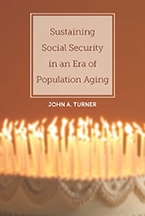
Social Security currently lacks the financing to pay for benefits already promised and the Congressional Budget Office projects that insolvency will occur in 2031. While many proposals for fixing the system have been floated, most are little more than bandages that stem the bleeding but fail to address the underlying malady.
As John A. Turner points out in his new book Sustaining Social Security in an Era of Population Aging, “[T]he fundamental problem is that the current demographic era where the old-age dependency ratio (the ratio of Social Security beneficiaries to covered workers) is increasing, the Social Security benefit formula causes benefits to grow faster than the tax revenues that finance them.” While seemingly a problem of demographics (which can’t be fixed), Turner argues that the solution to the long-term health of Social Security lies in politically-acceptable periodic reforms of the formula used to determine benefits. Specifically, he endorses a set of reforms that address increased life expectancy, the growing relationship between income and life expectancy, the decline in the physical demands of jobs, the rise in income inequality, and the increasing poverty seen among the older population.
